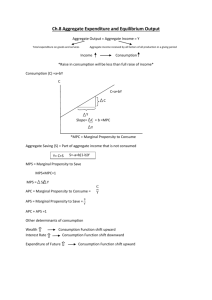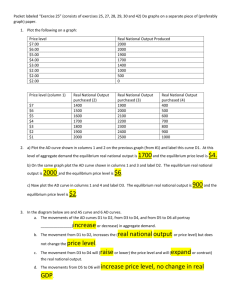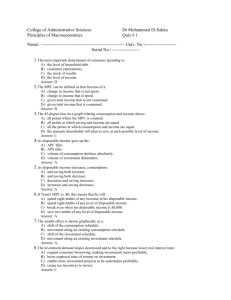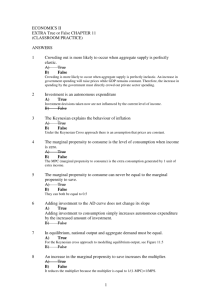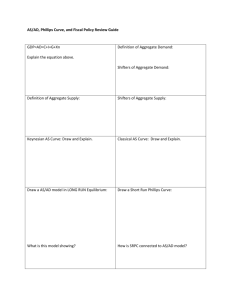Exercises 25, et al
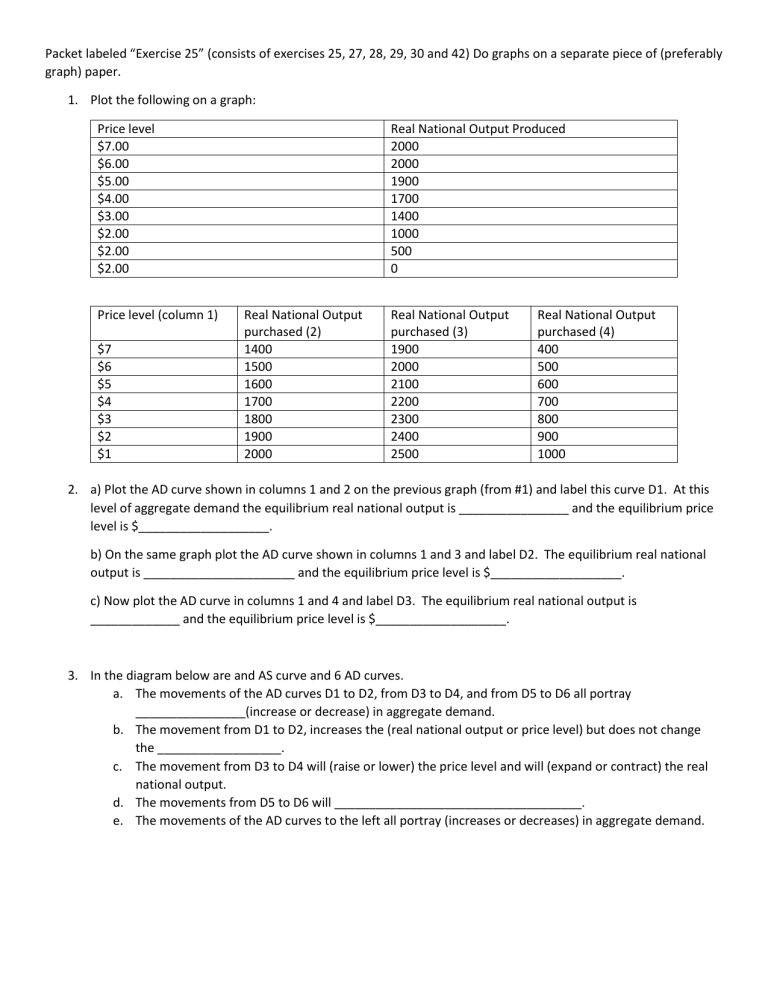
Packet labeled “Exercise 25” (consists of exercises 25, 27, 28, 29, 30 and 42) Do graphs on a separate piece of (preferably graph) paper.
1.
Plot the following on a graph:
Price level
$7.00
$6.00
$5.00
$4.00
$3.00
$2.00
$2.00
$2.00
Real National Output Produced
2000
2000
1900
1700
1400
1000
500
0
Price level (column 1) Real National Output purchased (2)
$7 1400
$6
$5
$4
$3
$2
$1
1500
1600
1700
1800
1900
2000
Real National Output purchased (3)
1900
2000
2100
2200
2300
2400
2500
Real National Output purchased (4)
400
500
600
700
800
900
1000
2.
a) Plot the AD curve shown in columns 1 and 2 on the previous graph (from #1) and label this curve D1. At this level of aggregate demand the equilibrium real national output is ________________ and the equilibrium price level is $___________________. b) On the same graph plot the AD curve shown in columns 1 and 3 and label D2. The equilibrium real national output is ______________________ and the equilibrium price level is $___________________. c) Now plot the AD curve in columns 1 and 4 and label D3. The equilibrium real national output is
_____________ and the equilibrium price level is $___________________.
3.
In the diagram below are and AS curve and 6 AD curves. a.
The movements of the AD curves D1 to D2, from D3 to D4, and from D5 to D6 all portray
________________(increase or decrease) in aggregate demand. b.
The movement from D1 to D2, increases the (real national output or price level) but does not change the __________________. c.
The movement from D3 to D4 will (raise or lower) the price level and will (expand or contract) the real national output. d.
The movements from D5 to D6 will ____________________________________. e.
The movements of the AD curves to the left all portray (increases or decreases) in aggregate demand.
Price Level
D1 D2 D3 D4
Real National Output
D5 D6
4.
In the diagram below there are 2 aggregate supply curves and 3 aggregate demand curves. a.
The movement of the aggregate supply curve from S1 to S2 represents a(n) (increase or decrease) in aggregate supply. This change in aggregate supply in each of the 3 ranges along aggregate supply curve will (raise or lower) the price level and (expand or contract) the real national output. b.
The movement of aggregate supply from S2 to S1 portrays a(n) _____________________in aggregate supply and in each of the 3 ranges will ___________________the price level and _______________the real national output.
Price level AS1 AS2
AD1 AD2
AD3
Exercise 27 MPC
The marginal propensity to save (MPS) is the fraction saved of any change in disposable income. The MPS is equal to the change in saving divided by the change in disposable income. The MPC plus the MPS equals 1. Why?
Using the data below, calculate the MPC and MPS at each level of disposable income. The first one is completed as an example
Level of output and income
Consumption Savings Marginal Propensity to Consume (MPC)
Marginal Propensity to save (MPS)
12000
13000
14000
15000
12100
13000
13600
14500
-100
0
200
500
.9 .1
16000 15100 900
Exercise 28 Consumption Function
In the nation of Chaos-on-the-Styx, there is the following relationship between consumption expenditure and disposable income:
Consumption expenditure (in billions of $)
120
200
270
330
380
420
Disposable Income (in billions of $)
100
200
300
400
500
600
1.
Plot the consumption function for this nation.
2.
Plot the savings function for this nation.
3.
If the nation of Chaos consumes $5B more at each level of DI, is this a shift in the consumption schedule or a movement along the consumption schedule?
4.
If a nation consumes $5B more at each level of DI, draw the new consumption function and the new savings function. If no change occurs at either function, write “no change”.
Exercise 29 Consumption Schedule
1.
Indicate in the space to the right of each of the following events whether the event will increase (+) or decrease
(-) the consumption schedule: a.
Development of consumer expectations that prices will be higher in the future _____________ b.
Gradual shrinkage in the quantity of real assets owned by consumers ______________ c.
Increase in the volume of consumer indebtedness _______________ d.
Growing belief that disposable income will be lower in the future _______________ e.
Rumors that a current shortage of consumer goods will soon disappear _______________
f.
Rise in the actual level of disposable income _________________ g.
A buildup in the dollar size of the financial assets owned by consumers _________________ h.
Development of a belief by consumers that the federal government can and will prevent depressions in the future _________________
Exercise 30 Multiplier
The good people in Econland lived on an isolated island One year, a stranger arrived and built a $1000 house. If the marginal propensity to consume was 50%, what happened to the GDP in Econland? It increased by $2000:
Round
1
2
3
4
All rounds
Income
1000
500
250
125
2000
Consumption
500
250
125
62.50
1000
Savings
500
250
125
62.50
1000
This change in GDP is due to the multiplier. It shows how a change in investment causes a multiplied effect on GDP. In this case, the multiplier is 2.
1.
Would the multiplier be larger or smaller if people saved more of their additional income? ____________
2.
What would happen to the multiplier if people saved al of their income? __________________ What would happen if people spent all of their income? _____________________
3.
Government spending has the same effect as investment spending. If the multiplier were 4, how much would the government have to spend to increase aggregate demand by $1M? __________________
4.
If the government needed to cut aggregate demand by $2M and the multiplier were 4, how much would government spending have to be reduced?___________________
5.
How does the multiplier explain why changes in investment spending cause large fluctuations in GDP?
Size of the multiplier: Multiplier = 1/1-MPC
Econoland: M = 1/1 - 0.5 = 1/ 0.5 = 2
6.
What is the multiplier if MPC = 0.75? _________
7.
What is the multiplier if MPC = 0.9? __________
8.
What is the multiplier if the marginal propensity to save (MPS) = 0.2? _____________
9.
Why is the multiplier important in understanding business cycles?
Exercise 42 Fiscal Policy (CHAPTER 13 in text)
Decide whether each of the following fiscal policies of the federal government is expansionary or contractionary. Write which one and a brief reason why.
1.
The government cuts business and personal income taxes and increases its own spending.
2.
The government increases the personal income tax, social security tax, and corporate income tax. Government spending stays the same.
3.
The government reduces the wages of its employees while raising taxes on consumers and businesses. Other government spending remains the same.
A
Objective for
Aggregate Demand
B
Action on Taxes
C
Action on
Government
Spending
National unemployment rises to 12%
Inflation is strong and its rate is now
14% per year
Surveys show consumers are losing confidence in the economy, retail sales are weak, and business inventories are increasing rapidly
Business sales and investments are expanding rapidly and economists believe a strong inflation lies ahead
Inflation persists while unemployment stays high
For each scenario:
4.
Column A: depending on what you think should happen to AD, write increase/decrease
5.
Column B: write increase/decrease for what you would do with taxes
D
Effect on Budget
6.
Column C write increase/decrease for what you would do with government spending
7.
Column D: Write “toward deficit” if you wish to increase the deficit or reduce surplus Write “toward surplus” if you wish to reduce the deficit or increase the surplus


